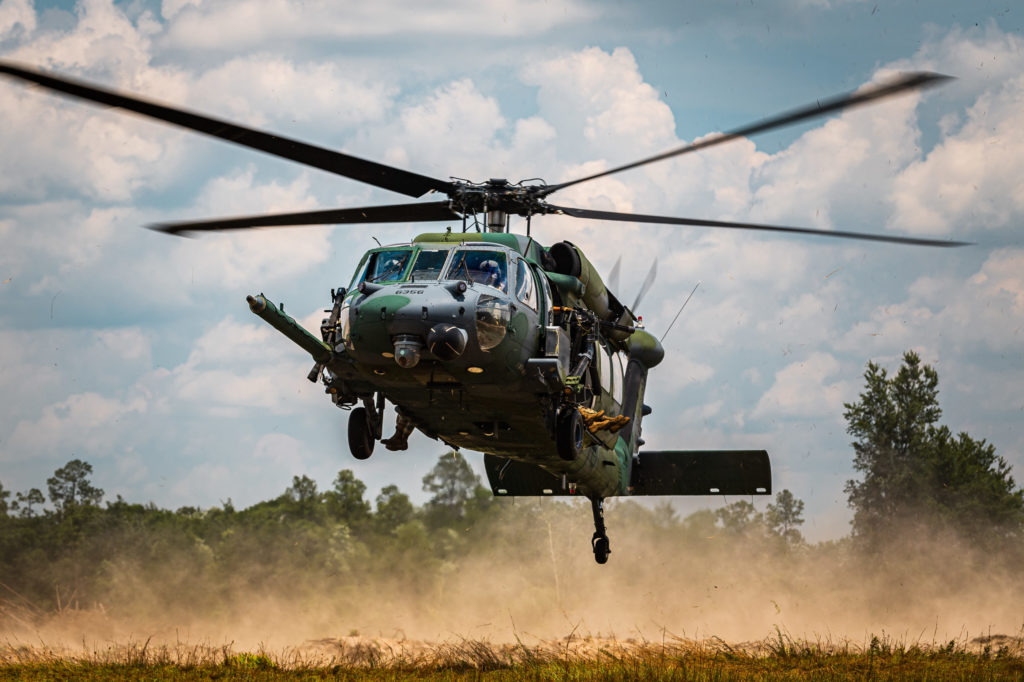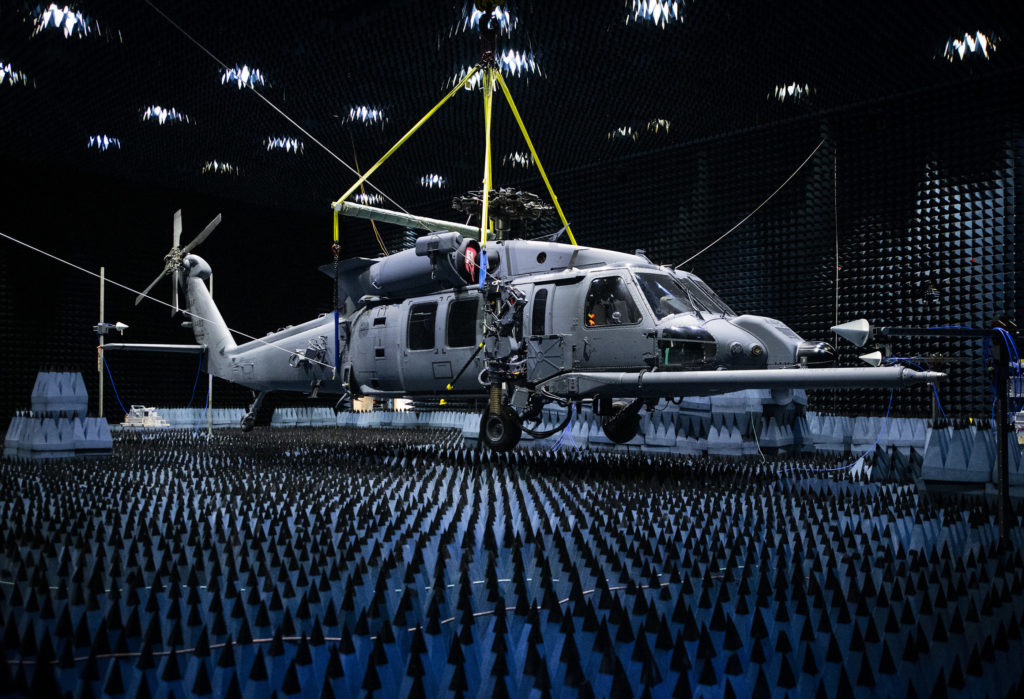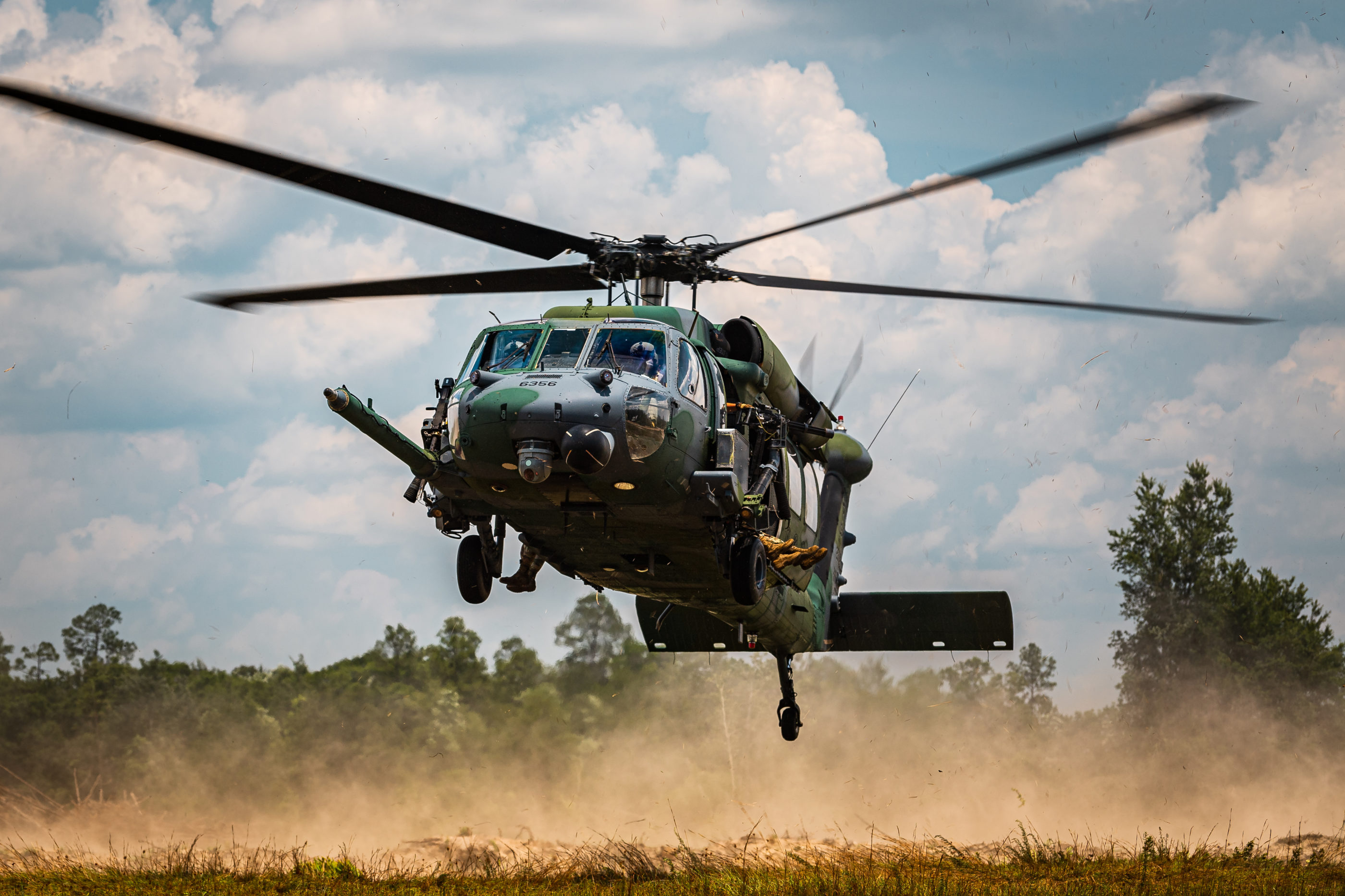The U.S. Air Force is quietly cancelling a program to equip rescue helicopters with sensors that help pilots avoid potentially fatal obstacles and land safely when they cannot see the ground.
Led by the Army, the U.S. military rotorcraft community has long sought a technological solution that would allow pilots to see through clouds of smoke and dust roiled up by helicopter downwash, as well as hard-to-spot obstacles like electrical wires. Such “degraded visual environment” (DVE) sensors are currently fielded by the 160th Special Operations Aviation Regiment and an Army medical evacuation unit.

It was one of those sensors, made by Sierra Nevada Corp., that the Air Force planned to install on its HH-60G Pave Hawk search-and-rescue helicopters. In 2019, the service awarded Sierra Nevada a $75 million contract to install degraded visual environment systems (DVES) on 85 HH-60G Pave Hawk helicopters.
The DVE system fuses real-time data from an array of sensors including millimeter wave radar, light detection and ranging (LIDAR) , infrared cameras, and various a-priori digital terrain data to provide pilot with “synthetic vision” through extreme rain, fog, smoke, dust and other obstructions, according to the company.
Up to the current fiscal year, the service spent about $50 million to prepare for integration of DVE sensors onto the HH-60, but funding to continue the program was nixed from the Air Force’s 2022 budget request.
That omission caught the attention of Rep. Donald Norcross, D-New Jersey, who chairs the House Armed Services subcommittee on tactical air and land forces. He put the question to Air Force officials at a hearing of the subcommittee on June 30.
Darlene Costello, acting assistant secretary of the Air Force for acquisition, technology, and logistics said the decision to not purchase any more DVE equipment for the HH-60G was made based on an accelerated divestment of the aircraft ahead of its replacement with the new HH-60W.
“As the timeline for the aircraft moved out to the right and the timeline for integration of [DVE], basically the return on investment of when we’d be able to install it, before we would be removing the aircraft from our inventory, became part of the equation,” Costello testified. “That led to assessing the risk of what we were going to fund and not fund. Our combatant commander looked at that and decided to not fund at this point for that particular aircraft.”
Major General Richard Moore, director of programs for the deputy chief of staff of the Air Force for plans and programs, said installing DVE sensors on the HH-60G would be costly and would not be completed before the aircraft are retired from service.
“As we change the divestiture profile of the HH-60G . . . to the install timeline and the amount of investment, it just did not appear to be a good use of taxpayer dollars,” Moore said. “It doesn’t mean we don’t believe in the system, and it doesn’t mean that it’s not very productive for the pilots and very helpful for them, it just didn’t make sense in the particular case for this particular aircraft.”

As the HH-60W “Jolly Green II” becomes available — two of an eventual fleet of 105 have been delivered to the Air Force — the Air Force is hastening divestment of the legacy G-model Pave Hawk. Because the Golf-model will be out of the Air Force inventory by 2026 and the Whiskey-model already coming online, it made “fiscal sense” to defer DVE sensors to a future upgrade of the new helicopter, Moore said.
“We have the opportunity to incorporate that into the new aircraft,” Moore said. “It is not a part of the baseline, to my knowledge, but we do have the opportunity to incorporate it and, as we’re able with available funds, that’s certainly something that we’ll look at.”
The Air Force has funded the HH-60W at what commanders “believe is the minimum combat configuration” with plans for “additional modifications” in future to enhance its capabilities, Moore said. Sikorsky already holds a $1 billion contract for upgrades to the HH-60W, but DVE is not listed among the desired enhancements to the baseline configuration. They include avionics (both hardware and software), structures, mandates, deficiency reports, diminishing manufacturing sources and training systems, and will be completed over five years.
First fielded HH-60Ws will come with no obstacle avoidance sensors or terrain following radar. The Air Force insists those capabilities, some of which are available on the legacy Pave Hawk, will be delivered in later iterations of the Jolly Green II.
“At this point, with the resources that we have, all of the modifications that we originally planned for the HH-60W are included in the current aircraft,” Moore said. “That technology will be available for the HH-60W. But, as we accelerated the timeline for the G-model, compared to the installation timeline, it didn’t seem to be fiscally responsible.”
Moore acknowledged the DVE sensors would provide “a significant enhancement for the pilots and we will continue to look, as we go forward with new fleets, at incorporating that into either the baseline configuration or into a modification later on.”
During the past two decades of fighting in Iraq, Afghanistan and elsewhere, the Air Force’s Pave Hawks have been flown hard in some of the toughest combat conditions. The service’s 82 HH-60G primary and backup helicopters have been flown hard and parked wrecked after harrowing missions rescuing wounded troops and delivering them to lifesaving care.
Numerous HH-60Gs and their crews have been lost in those war zones with many of those crashes attributed to hard landings, rollovers and other mishaps in DVE conditions and/or collisions with unseen obstacles.
Efforts to field DVE solutions were renewed following the March 2018 crash of “Jolly 51,” a Pave Hawk assigned to the 106th Rescue Wing of the New York Air National Guard. All seven service members aboard were killed when the helicopter struck a steel cable and crashed near the Iraq-Syria border.

“At the time of the incident, the aircrew lacked the onboard capability to detect uncharted wires and obstacles,” then-Democratic Leader of the U.S. Senate Charles Schumer wrote to the Senate Armed Services Committee in May 2019. “I am concerned that insufficient steps have been taken to address this threat and procure the critical life-saving technology aircrews need.”
In a remarkable feat of hair splitting, Moore said the lack of DVE equipment on the legacy HH-60G and on initial fielded variants of the HH-60W was not a “safety of flight issue.”
“I don’t know that I would say it is a requirement for a safe aircraft,” Moore said. “It is an enhancement to the aircraft that does improve safety, but we don’t believe it is a safety of flight issue to not have it on the aircraft.”
The Army, through the 160th SOAR, has doggedly pursued DVE technologies that allow pilots to see through smoke and dust and identifies potential obstacles in their flight path. The sensors are also flying with one of the Army’s medical evacuation (Medevac) companies, according to Maj. Gen. David Francis, the Army’s chief aviator.
DVE is “absolutely on the forefront of our minds,” Francis told reporters during a July 21 conference call. “We used to talk about owning the night, now we are going to own the environment, whatever that is. . . . It’s critical for us to be able to fight in all conditions. This is a step towards that.”
DVE sensors are flying on Army HH-60M, MH-60M and Special Operations MH-47G Chinook helicopters, according to Maj. Gen. Wally Rugen, who heads Future Vertical Lift efforts at Army Futures Command. The Army gathered data on those systems to generate a formal requirement that should be approved by Army officials in coming months.
“We flew a prototype capabilities and informed our requirement to ensure that we have something that’s very useful, effective, and affordable for our force,” Rugen said during the call. “We are currently flying. We’re collecting data and that’s to inform the requirement. . . . We’re very excited to learn what we’ve learned, see what we see is the state of the technology and, again, it’s in a good spot.”










My nephew is Major Christopher Tripp Zanetis, killed with 6 of his brothers because they flew into a power line in Afghanistan in 2018 flying “Jolly 1” referenced above. I would like to suggest that if any of the people involved in making this decision, including Major General Moore, had loved ones die as a result of an accident that this equipment would have prevented, they may have added, “weighing the potential loss of life in the period when the HH-60 is still in use” to their equation.
(Par. 8: Darlene Costello and combatant commander cited a major consideration as, “basically the return on investment of when we’d be able to install it, before we would be removing the aircraft from our inventory. O
On behalf of one of the extraordinary 7 lives lost at that time, I suggest the conversation be expedited and the necessary equipment placed in all hh-60 pave Hawks currently in use. To do otherwise is negligent if even one more service member loses his life.